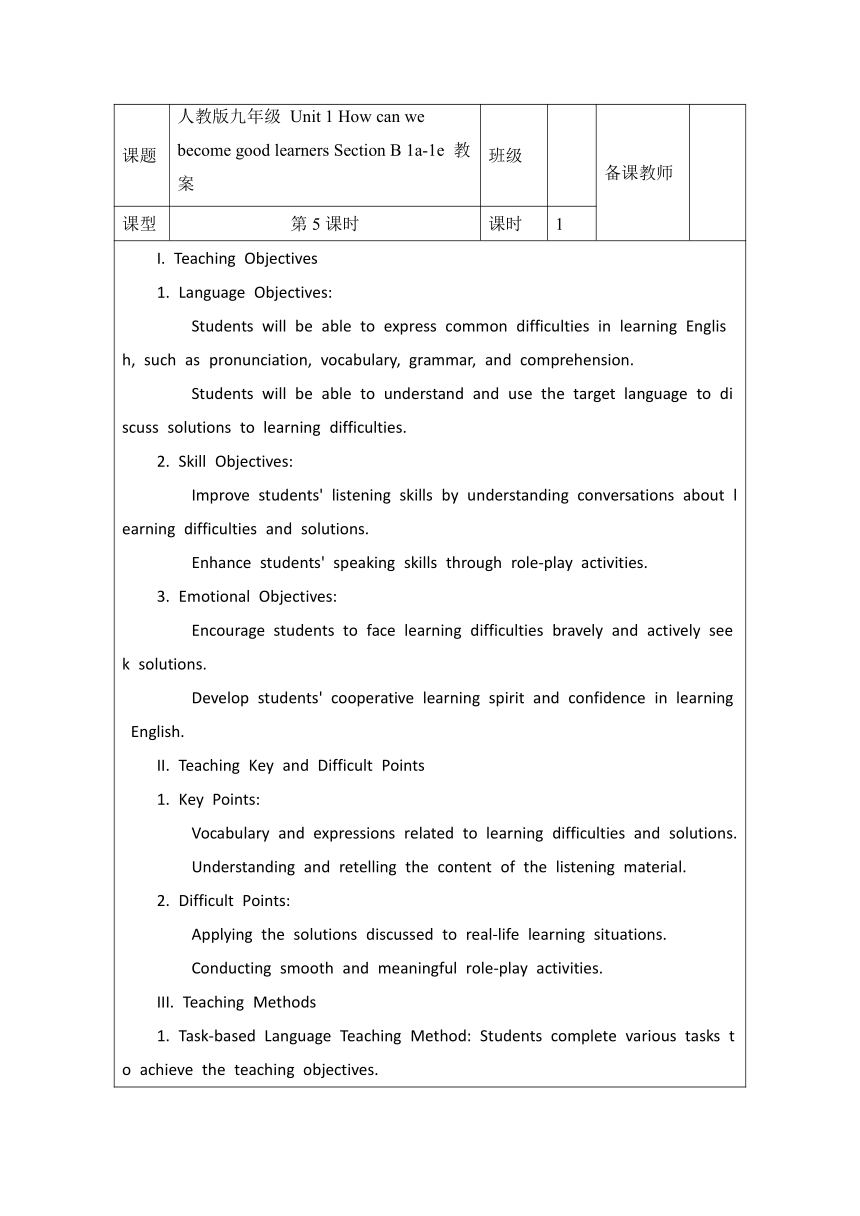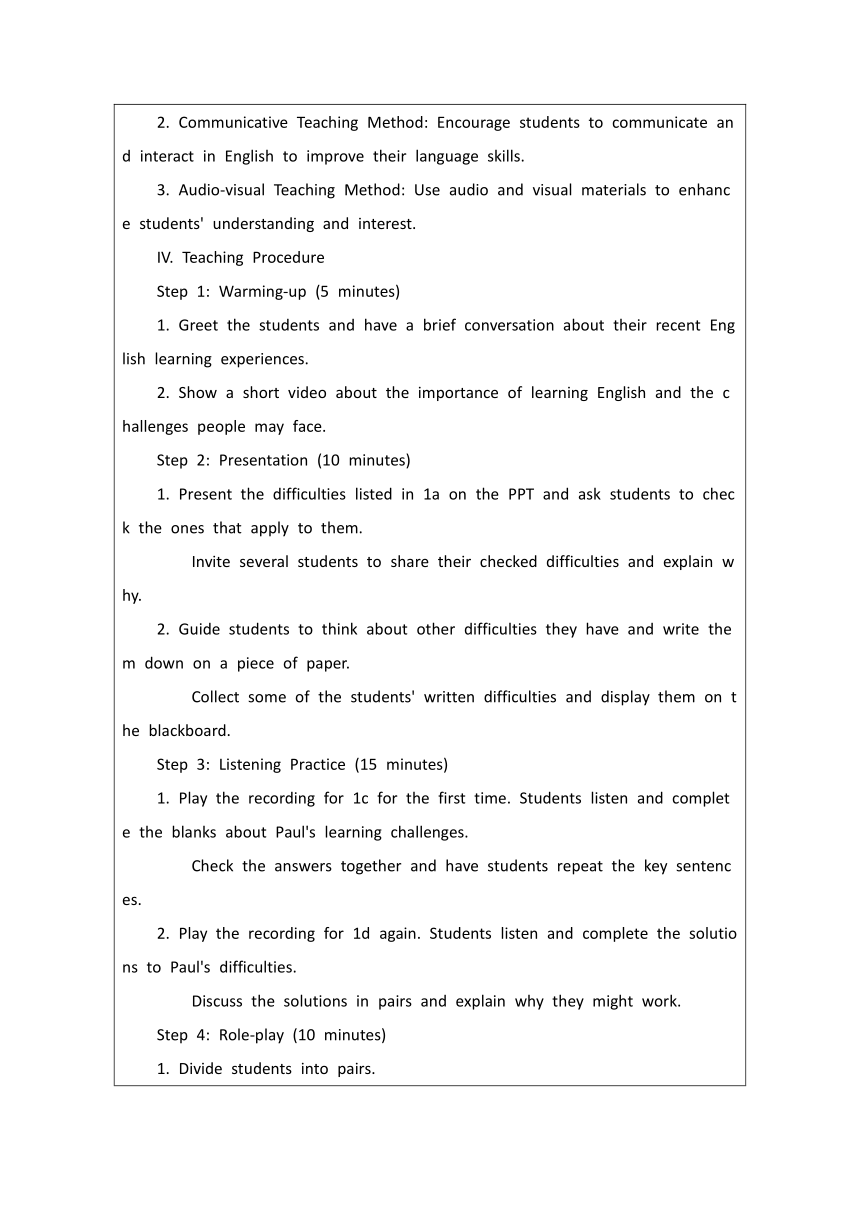人教版九年级 Unit 1 How can we become good learners Section B 1a-1e 英文教案(表格式)
文档属性
| 名称 | 人教版九年级 Unit 1 How can we become good learners Section B 1a-1e 英文教案(表格式) |

|
|
| 格式 | docx | ||
| 文件大小 | 22.2KB | ||
| 资源类型 | 教案 | ||
| 版本资源 | 人教新目标(Go for it)版 | ||
| 科目 | 英语 | ||
| 更新时间 | 2024-10-14 08:59:09 | ||
图片预览


文档简介
课题 人教版九年级 Unit 1 How can we become good learners Section B 1a-1e 教案 班级 备课教师
课型 第5课时 课时 1
I. Teaching Objectives 1. Language Objectives: Students will be able to express common difficulties in learning English, such as pronunciation, vocabulary, grammar, and comprehension. Students will be able to understand and use the target language to discuss solutions to learning difficulties. 2. Skill Objectives: Improve students' listening skills by understanding conversations about learning difficulties and solutions. Enhance students' speaking skills through role-play activities. 3. Emotional Objectives: Encourage students to face learning difficulties bravely and actively seek solutions. Develop students' cooperative learning spirit and confidence in learning English. II. Teaching Key and Difficult Points 1. Key Points: Vocabulary and expressions related to learning difficulties and solutions. Understanding and retelling the content of the listening material. 2. Difficult Points: Applying the solutions discussed to real-life learning situations. Conducting smooth and meaningful role-play activities. III. Teaching Methods 1. Task-based Language Teaching Method: Students complete various tasks to achieve the teaching objectives. 2. Communicative Teaching Method: Encourage students to communicate and interact in English to improve their language skills. 3. Audio-visual Teaching Method: Use audio and visual materials to enhance students' understanding and interest. IV. Teaching Procedure Step 1: Warming-up (5 minutes) 1. Greet the students and have a brief conversation about their recent English learning experiences. 2. Show a short video about the importance of learning English and the challenges people may face. Step 2: Presentation (10 minutes) 1. Present the difficulties listed in 1a on the PPT and ask students to check the ones that apply to them. Invite several students to share their checked difficulties and explain why. 2. Guide students to think about other difficulties they have and write them down on a piece of paper. Collect some of the students' written difficulties and display them on the blackboard. Step 3: Listening Practice (15 minutes) 1. Play the recording for 1c for the first time. Students listen and complete the blanks about Paul's learning challenges. Check the answers together and have students repeat the key sentences. 2. Play the recording for 1d again. Students listen and complete the solutions to Paul's difficulties. Discuss the solutions in pairs and explain why they might work. Step 4: Role-play (10 minutes) 1. Divide students into pairs. 2. Ask them to use the information from 1c and 1d to have a role-play conversation. One student plays as Paul and shares the difficulties, and the other gives suggestions. 3. Walk around the classroom to offer guidance and encouragement. 4. Invite several pairs to perform in front of the class. Step 5: Summary and Homework (5 minutes) 1. Summarize the main points of this lesson, emphasizing the importance of identifying learning difficulties and finding appropriate solutions. 2. Assign homework: Ask students to write a short paragraph about their own learning difficulties and possible solutions. V. Board Design On the left side of the blackboard: Common Learning Difficulties: Can't pronounce words correctly Can't understand spoken English Don't know how to increase reading speed Can't spell words Make mistakes in grammar In the middle: Paul's Learning Challenges: Can't get the pronunciation right Forgets a lot of new words Can't always understand when people talk to him Doesn't get much writing practice On the right side of the blackboard: Solutions: Listen more Write new words in a notebook and study at home VI. Teaching Reflection After the class, reflect on the teaching process and students' performance. Analyze whether the teaching objectives were achieved, what went well and what needs improvement. Make adjustments for future teaching to better meet the needs of students.
课型 第5课时 课时 1
I. Teaching Objectives 1. Language Objectives: Students will be able to express common difficulties in learning English, such as pronunciation, vocabulary, grammar, and comprehension. Students will be able to understand and use the target language to discuss solutions to learning difficulties. 2. Skill Objectives: Improve students' listening skills by understanding conversations about learning difficulties and solutions. Enhance students' speaking skills through role-play activities. 3. Emotional Objectives: Encourage students to face learning difficulties bravely and actively seek solutions. Develop students' cooperative learning spirit and confidence in learning English. II. Teaching Key and Difficult Points 1. Key Points: Vocabulary and expressions related to learning difficulties and solutions. Understanding and retelling the content of the listening material. 2. Difficult Points: Applying the solutions discussed to real-life learning situations. Conducting smooth and meaningful role-play activities. III. Teaching Methods 1. Task-based Language Teaching Method: Students complete various tasks to achieve the teaching objectives. 2. Communicative Teaching Method: Encourage students to communicate and interact in English to improve their language skills. 3. Audio-visual Teaching Method: Use audio and visual materials to enhance students' understanding and interest. IV. Teaching Procedure Step 1: Warming-up (5 minutes) 1. Greet the students and have a brief conversation about their recent English learning experiences. 2. Show a short video about the importance of learning English and the challenges people may face. Step 2: Presentation (10 minutes) 1. Present the difficulties listed in 1a on the PPT and ask students to check the ones that apply to them. Invite several students to share their checked difficulties and explain why. 2. Guide students to think about other difficulties they have and write them down on a piece of paper. Collect some of the students' written difficulties and display them on the blackboard. Step 3: Listening Practice (15 minutes) 1. Play the recording for 1c for the first time. Students listen and complete the blanks about Paul's learning challenges. Check the answers together and have students repeat the key sentences. 2. Play the recording for 1d again. Students listen and complete the solutions to Paul's difficulties. Discuss the solutions in pairs and explain why they might work. Step 4: Role-play (10 minutes) 1. Divide students into pairs. 2. Ask them to use the information from 1c and 1d to have a role-play conversation. One student plays as Paul and shares the difficulties, and the other gives suggestions. 3. Walk around the classroom to offer guidance and encouragement. 4. Invite several pairs to perform in front of the class. Step 5: Summary and Homework (5 minutes) 1. Summarize the main points of this lesson, emphasizing the importance of identifying learning difficulties and finding appropriate solutions. 2. Assign homework: Ask students to write a short paragraph about their own learning difficulties and possible solutions. V. Board Design On the left side of the blackboard: Common Learning Difficulties: Can't pronounce words correctly Can't understand spoken English Don't know how to increase reading speed Can't spell words Make mistakes in grammar In the middle: Paul's Learning Challenges: Can't get the pronunciation right Forgets a lot of new words Can't always understand when people talk to him Doesn't get much writing practice On the right side of the blackboard: Solutions: Listen more Write new words in a notebook and study at home VI. Teaching Reflection After the class, reflect on the teaching process and students' performance. Analyze whether the teaching objectives were achieved, what went well and what needs improvement. Make adjustments for future teaching to better meet the needs of students.
同课章节目录
- Unit 1 How can we become good learners.
- Section A
- Section B
- Unit 2 I think that mooncakes are delicious!
- Section A
- Section B
- Unit 3 Could you please tell me where the restroom
- Section A
- Section B
- Unit 4 I used to be afraid of the dark.
- Section A
- Section B
- Unit 5 What are the shirts made of?
- Section A
- Section B
- Review of Units 1-5
- Unit 6 When was it invented?
- Section A
- Section B
- Unit 7 Teenagers should be allowed to choose their
- Section A
- Section B
- Unit 8 It must belong to Carla.
- Section A
- Section B
- Unit 9 I like music that I can dance to.
- Section A
- Section B
- Unit 10 You're supposed to shake hands.
- Section A
- Section B
- Review of Units 6-10
- Unit 11 Sad movies make me cry.
- Section A
- Section B
- Unit 12 Life is full of the unexpected
- Section A
- Section B
- Unit 13 We're trying to save the earth!
- Section A
- Section B
- Unit 14 I remember meeting all of you in Grade 7.
- Section A
- Section B
- Review of Units 11-14
